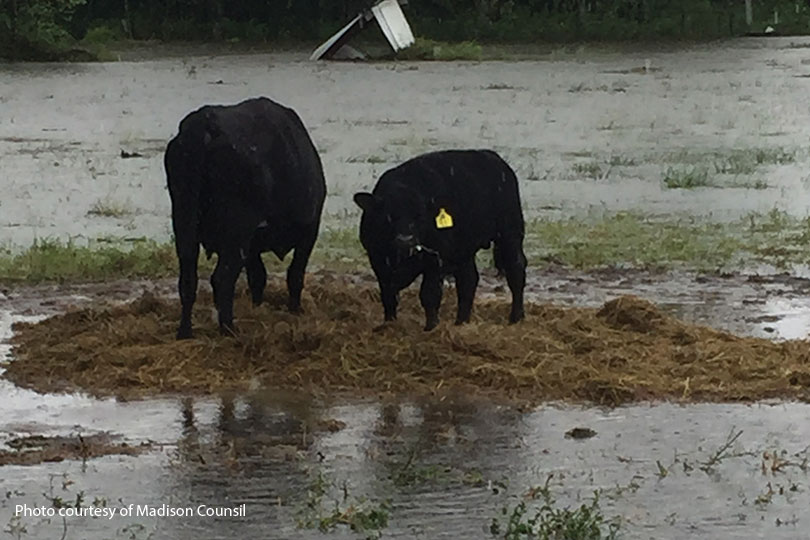By Shala Watson
Communications Specialist
More than 1 million cattle were in the disaster area affected by Hurricane Harvey, according to U.S. Department of Agriculture data. As the recovery efforts continue, livestock owners should be aware of salt poisoning and water salinity concerns.
Dr. Joe Paschal with the Texas A&M AgriLife Extension Service said ranchers need to pay special attention to water supplies and signs of salt poisoning in hurricane-affected areas.
He urged livestock owners along the Texas coast to get a salinity test or a salinity meter to check for high levels of salinity.
“Typically, anything less than 7,000 parts per million (ppm), although it is not ideal, will be safe for livestock to drink,” Paschal told the Texas Farm Bureau (TFB) Radio Network. “We prefer that to be less than 5,000 ppm.”
The amount of drinkable water should also be limited to cattle that have been in flooded water for a long period of time, according to Paschal.
“Don’t be in a hurry to fill them up,” he said. “Don’t let them gorge on water.”
Paschal recommends giving cattle and horses maybe a gallon or two every hour or so.
He said signs of salt toxicity include incoordination, staggering or even laying down.
“In vary severe cases, they might even be walking around on their joints rather than on their feet,” Paschal said. “In cases that severe, they will need veterinary attention.”
In less severe cases, cattle can be recovered with smaller amounts of water over a period of several hours, Paschal said.
Animals that have been standing in water for extended periods of time will drink whatever is in front of them.
“It might be brackish water. It might be river water. It might be contaminated water,” Paschal said. “For cattle that aren’t accustomed to it, that can be a significant issue just on the salinity side.”
He said other possible water contaminants like petroleum products and sewage can also be a concern.
Cattle and horses can only go without water for around three days before you begin to see signs of water deprivation, according to Paschal.
He said the same rule applies for cattle that have been water deprived and cattle that have consumed saline water.
“Really thirsty cattle will gorge on water, and you’ll start to see these toxic effects of having too much water too quickly,” Paschal said.
He said cattle will generally drink about a gallon of water per hundred pounds of body weight during the day. Cattle that are very gaunt can consume twice that amount.
He said livestock that have been in standing water for a long period of time can also develop feet and leg problems.
“Water is sort of corrosive on tissues,” Paschal said. “It affects circulation. It will affect the blood vessels in terms of vessel constriction if the water is particularly cold.”
He urges ranchers to be observant for any kind of feet and leg issues as livestock are moved out of flood waters.
Click here to listen to more of Paschal’s comments on the TFB Radio Network.


Cattle will drink a gallon of water per HUNDRED TONS OF BODY WEIGHT? Maybe 100 POUNDS? I’ll raise my
glass but I can’t drink to that.
Thanks,